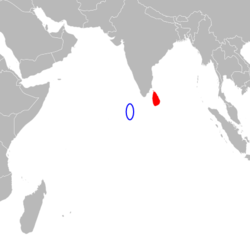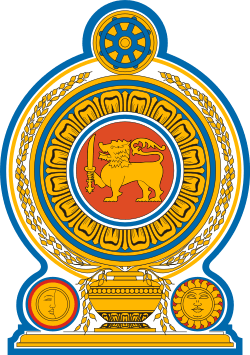Maldives–Sri Lanka relations
 |
|
Maldives |
Sri Lanka |
|---|---|
Maldives–Sri Lanka relations, or official and economic relations between the neighboring Indian Ocean countries of the Maldives and Sri Lanka, have been positive since the Maldives became independent in 1965. The Maldives first established a mission in Sri Lanka in July 1965, and today has a high commission in Colombo.[1] Sri Lanka has a high commission in Malé.[2] Both countries were founding members of the South Asian Association for Regional Cooperation (SAARC) in December 1985.[3]
History
The earliest settlers in the Maldives were probably from southern India. Indo-European speakers followed them from Sri Lanka in the fourth and fifth centuries BC. In the 12th century AD, sailors from East Africa and Arab countries came to the islands. Today, the Maldivian ethnic identity is a blend of these cultures, reinforced by religion and language. According to Maldivian legend, a Sinhalese prince named KoiMale was stranded with his bride, daughter of the king of Sri Lanka, in a Maldivian lagoon and stayed on to rule as the first sultan. The Maldivians speak Dhivehi, closely related to the Sinhala language of Sri Lanka.[4] The Maldives became a British Protectorate in the 19th century and the Maldivian monarchs were granted a good measure of self-governance. The Maldives gained total independence in 1965, and soon after established formal diplomatic relations with Sri Lanka.[1][5]
Official relations
In July 1976 the governments of the Maldives, Sri Lanka and India reached an agreement fixing the trijunction point between the three countries in the sea beyond the Gulf of Mannar.[6]
In April 2006 officials including the Ministers of Education from the two countries participated in a 5-day workshop sponsored by UNESCO to establish plans for measuring progress towards EFA (Education for All) goals.[7]
In February 2007, Sri Lankan President Mahinda Rajapaksa made a three-day official visit to the Maldives, expected to further consolidate the existing bilateral links between the two countries, and to strengthen cooperation in trade, tourism, education and fisheries.[8]
At a January 2009 meeting of energy ministers and senior officials of SAARC countries in Colombo the two countries discussed closer collaboration in joint energy policies.[9]
In June 2009, the President of the Maldives Mohamed Nasheed made a two-day official visit to Sri Lanka where he met with Sri Lankan President Mahinda Rajapaksa and discussed issues of bilateral and regional interest. Mr. Nasheed congratulated Mr. Rajapaksa on eliminating LTTE terrorism.[10]
Defence
Maldives Defence Forces trained by Sri Lanka Military. Specially Special Forces of the MNDF were trained at the Sri Lanka Army Commando Regiment regiment school and Sri Lanka Army Special Forces Regiment training academy in Maduru Oya, Sri Lanka. Maldivian Coast Guard fleet consists of vessels made by Colombo Dockyard.
Economic relations
Until the early 1970s, 65% of the Maldives imports from South Asia came from Sri Lanka, compared to 32% from India.[11]
The economy of the Maldives is heavily dependent on tourism, with tour operators often based in Sri Lanka and packages including both countries.[12]
In 2006 Sri Lanka Telecom and the Maldives state-run telephone company Dhivehi Raajjeyge Gulhun commissioned a US$20 million joint venture to lay an undersea fibre-optic cable connecting Male to Colombo in Sri Lanka, with Japan’s NEC Corp as the main supplier.[13]
In 2005, the International Finance Corporation, part of the World Bank, launched the US$10 million Sri Lanka-Maldives Enterprise Development Program to assist small and medium enterprises in the two countries.[14]
Environmental issues
The 2004 Indian Ocean earthquake triggered a major Tsunami on December 26, 2004 which caused great damage in Sri Lanka and other Indian Ocean countries, including the Maldives. In response, with assistance from the United States, the US$16.6 million Indian Ocean Tsunami Warning System (IOTWS) was established in 2005 to set up monitoring systems and share information between the countries at risk.[15] Global warming is a severe threat to the Maldives, with most of the islands less than 1.5 meters above sea level. The President Mohamed Nasheed has said he plans to set aside some of the $1 billion a year it receives from tourism to buy a new homeland. He has approached the government of Sri Lanka, among others, and is said to have received a favorable reception.[16]
See also
References
- 1 2 "High Commission of Maldives". High Commission of Maldives in Sri Lanka. Retrieved 2009-07-31.
- ↑ "Embassies of Sri Lanka". SAARC Tourism. Retrieved 2009-07-31.
- ↑ "South Asian Association for Regional Cooperation". SAARC. Retrieved 2009-07-31.
- ↑ "Background Note: Maldives". U.S. State Department. Retrieved 2009-07-31.
- ↑ "SOUTH ASIA :: MALDIVES". CIA: Central Intelligence Agency. Retrieved 2009-07-03.
- ↑ "Agreement between Sri Lanka, India and Maldives concerning the Determination of the Trijunction Point between the three Countries in the Gulf of Mannar 23, 24 and 31 July 1976" (PDF). United Nations. Retrieved 2009-07-31.
- ↑ "Sri Lanka and Maldives EFA Mid-Decade Assessment Planning Workshop". UNESCO Bangkok. 24–28 April 2006. Retrieved 2009-07-31.
- ↑ "Sri Lankan president to visit Maldives". People's Online Daily. February 10, 2007. Retrieved 2009-07-31.
- ↑ "Energy status and future outlook". Sri Lanka Daily News. 27 January 2009. Retrieved 2009-07-31.
- ↑ "Maldives, Sri Lanka discuss bilateral interests". The Hindu. Jun 20, 2009. Retrieved 2009-07-31.
- ↑ "Sri Lanka and Maldives fall victims to regional and international hegemonic powers". The Island (The Midweek Review ). February 27, 2008. Retrieved 2009-07-31.
- ↑ "Packaged pleasures in Sri Lanka and the Maldives". Travelmag. 4 Apr 2009. Retrieved 2009-07-31.
- ↑ "Sri Lanka-Maldives cable to bring down prices". TeleGeography. 14 December 2006. Retrieved 2009-07-31.
- ↑ "Sri Lanka and the Maldives". International Finance Corporation. Retrieved 2009-07-31.
- ↑ "US IOTWS Program Summary". USAID. Retrieved 2009-07-31.
- ↑ "Sinking island's nationals seek new home". CNN. November 11, 2008. Retrieved 2009-07-31.
